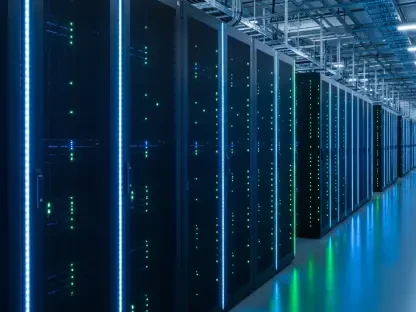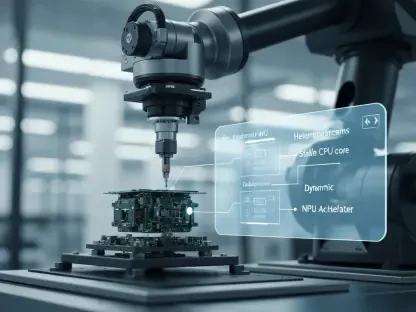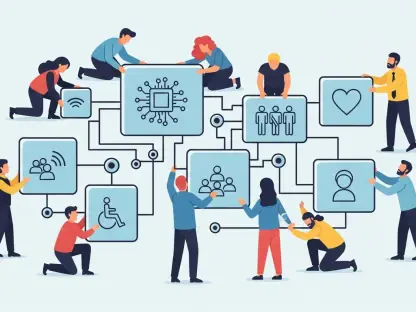Microsoft has soared to an unprecedented $4 trillion valuation, a landmark achievement that cements its position as a titan in the tech world, fueled by explosive growth in cloud computing and artificial intelligence through platforms like Azure. This financial feat, underscored by a quarterly revenue of $76.4 billion and a net income of $27.2 billion for the period ending June 30, reflects immense market confidence in the company’s innovative prowess. However, this triumph is marred by a sobering reality: the same year saw 25,000 employees laid off, with 9,100 let go in July alone. This jarring contrast between corporate prosperity and workforce reduction sparks a pressing debate about the hidden costs of such monumental success. As tech giants race to redefine the future with automation, the impact on human capital demands scrutiny, raising questions about whether financial milestones should overshadow the livelihoods of those who helped build them.
Corporate Success vs. Workforce Impact
Financial Triumphs and Employee Losses
Microsoft’s financial achievements are nothing short of staggering, with Azure alone generating $75 billion in annual revenue, marking a 34% increase year-over-year, while overall company revenue jumped 18% to $76.4 billion. This growth, driven by strategic investments in cloud and AI technologies, has propelled the company to a historic $4 trillion valuation, signaling robust investor faith in its future. Yet, beneath these headline-grabbing numbers lies a starkly different story for the workforce. The decision to cut 25,000 jobs across diverse sectors like Xbox, engineering, and management reveals a disconnect between profit margins and employee stability. This isn’t just a statistic; it represents thousands of individuals facing sudden career uncertainty, highlighting how corporate success can sometimes come at a profound personal cost to those who contributed to it.
The ripple effects of these layoffs extend far beyond individual employees, painting a troubling picture of the broader tech job market. Data from Indeed indicates a 36% decline in tech job postings since early 2020, a trend that compounds the challenges for displaced workers seeking new opportunities. For many, the loss of income and professional identity is compounded by a shrinking pool of available roles, making reemployment a daunting prospect. This situation underscores a critical tension: while Microsoft’s balance sheets reflect unparalleled growth, the human toll of such decisions casts a shadow over the narrative of success. The contrast prompts a deeper look into how companies balance financial imperatives with their responsibility to the workforce that drives their achievements.
Personal Toll and Industry Disparity
Beyond the raw numbers, the personal impact on laid-off employees reveals a human dimension often overlooked in corporate announcements. Families face financial strain, career trajectories are disrupted, and long-term employees find their loyalty unrewarded as they navigate an uncertain future. The emotional and economic burden is particularly acute for those in specialized fields like engineering, where skills may not easily transfer to other industries. Microsoft’s layoffs, while framed as strategic, leave a lasting mark on individuals who dedicated years to the company, raising ethical questions about the value placed on human capital in the pursuit of market dominance.
This disparity between corporate gains and employee losses mirrors a wider trend across the tech sector, where profit often trumps people. The industry celebrates record valuations and innovation, yet workers bear the brunt of restructuring deemed necessary for future growth. Reports of approximately 130,000 tech jobs lost this year, as noted by industry trackers, amplify the scale of this issue. For every headline about a tech giant’s success, there are countless untold stories of professionals struggling to adapt. This growing gap between industry prosperity and individual hardship calls for a reevaluation of how success is measured and at what cost it is achieved.
The Role of AI in Layoffs
Industry-Wide Shift to Automation
At the core of Microsoft’s workforce reductions is a strategic pivot to artificial intelligence, with an $80 billion investment signaling a bold bet on automation as the future of efficiency. This move isn’t unique to Microsoft; it reflects an industry-wide trend where tech giants like IBM, Meta, and Amazon are slashing jobs—8,000 at IBM and 5% of Meta’s staff planned for cuts—to fund AI initiatives. Leaders such as Satya Nadella and Amazon’s Andy Jassy articulate a vision where generative AI diminishes the need for certain roles, framing layoffs as an inevitable step toward progress. However, this shift prioritizes technological advancement over the immediate needs of employees, casting doubt on whether such transformations genuinely benefit all stakeholders or merely bolster bottom lines at the expense of human livelihoods.
The scale of this transition across the tech sector reveals a systemic reliance on AI as a cost-cutting tool, often with little regard for the broader implications. Companies justify these layoffs as necessary to stay competitive, arguing that automation will drive long-term gains by streamlining operations. Yet, the human cost is evident as thousands of workers, from clerical staff to seasoned engineers, are displaced with minimal safety nets. This pattern suggests a troubling precedent where technological investment supersedes workforce stability, prompting a critical examination of whether the promise of AI justifies the immediate hardship inflicted on employees. The narrative of progress must be weighed against the tangible losses faced by those left behind in this rush to automate.
Doubts About AI’s Readiness
Despite the enthusiasm for AI, significant skepticism surrounds its ability to fully replace skilled labor, particularly in complex fields like programming. The Stack Overflow Developer Survey reveals that while 84% of programmers use or plan to adopt AI tools, 46% express distrust in the results due to frequent errors, often spending more time correcting outputs than creating them. This data underscores a critical flaw: AI’s current capabilities fall short in roles requiring precision and nuanced judgment. Companies betting on automation to replace human expertise may be underestimating the gap between potential and reality, risking operational setbacks by prioritizing unproven tech over seasoned professionals.
Further evidence of AI’s limitations emerges from real-world incidents that highlight its unreliability in high-stakes environments. For instance, a coding platform’s AI system once damaged a production database, illustrating the potential for costly mistakes when automation is applied to intricate technical tasks. Such examples fuel doubts about whether tech giants are moving too quickly to phase out human workers in favor of systems that lack the finesse of human intellect. If AI fails to deliver on its promised efficiencies, companies like Microsoft could face challenges in recovering the talent they’ve let go, especially in a competitive job market. This uncertainty raises a pivotal question about the wisdom of sacrificing proven expertise for speculative technological gains.
Historical Patterns and Broader Implications
Cost-Cutting Through the Ages
The current wave of AI-driven layoffs at Microsoft and beyond echoes historical patterns of corporate cost-cutting, such as the outsourcing of call-center jobs to lower-cost regions in past decades. Then, as now, the primary goal was to reduce expenses, often at the expense of employee welfare, with little emphasis on enhancing productivity alongside innovation. AI represents the latest iteration of this strategy, positioned as a silver bullet for efficiency while sidelining the human element. This recurring focus on profit over people suggests a systemic issue within the tech industry, where short-term financial gains frequently overshadow long-term considerations for workforce stability and morale.
Examining these parallels reveals a consistent disregard for balancing technological advancement with employee support. While outsourcing displaced workers to cheaper locales, AI threatens to render entire roles obsolete, yet the underlying motive remains the same: slashing costs. This approach risks alienating talent and eroding trust, as employees witness their contributions devalued in favor of automation. The historical lens highlights a critical oversight—technology should ideally complement human skills, not replace them outright. As companies like Microsoft push forward with AI, the lessons of past cost-cutting endeavors urge a more thoughtful integration that prioritizes both innovation and the workforce that sustains it.
Challenges in the Tech Job Market
The tech job market presents a grim outlook for displaced workers, with widespread layoffs compounding the difficulty of finding new roles. Approximately 130,000 tech jobs have been lost this year, creating a highly competitive environment where opportunities are scarce. For many affected by Microsoft’s cuts, the challenge isn’t just financial but also professional, as specialized skills may not easily translate to other sectors. The scarcity of positions, coupled with a reported 36% drop in job postings since early 2020, paints a picture of an industry in flux, where the promise of high-paying AI roles remains elusive for most, accessible only to a select few with niche expertise.
This growing disparity between industry success and individual stability underscores a profound imbalance in the tech landscape. While companies celebrate record valuations and market dominance, the reality for many workers is one of insecurity and loss. The gap widens as coveted AI positions, rumored to command high salaries, remain out of reach for the majority of displaced professionals. Historically, the response to these challenges fell short, as companies often failed to provide adequate retraining or transition support. Moving forward, addressing this divide requires actionable steps—such as investing in upskilling programs and fostering partnerships for job placement—to ensure that technological progress doesn’t leave a generation of workers behind.









